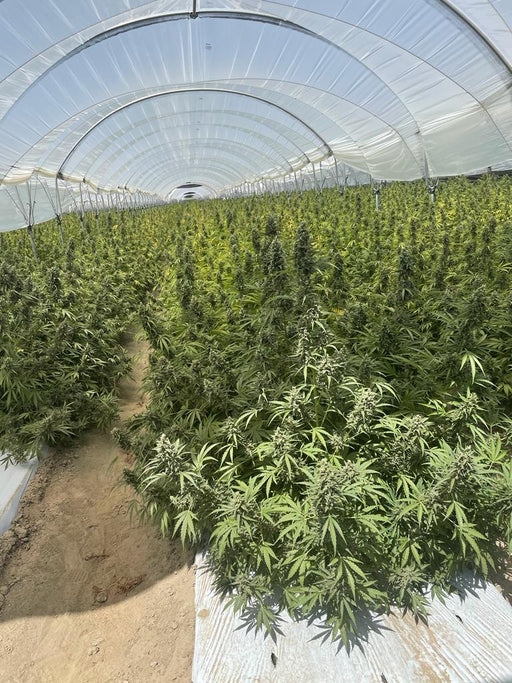
Growing Hemp for Hempcrete
Hempcrete is an eco-friendly building material made from the stalks of the hemp plant. It's a sustainable alternative to traditional building materials, such as concrete and brick, due to its high insulation value, low carbon footprint, and excellent moisture control.
In this article, we'll explore the process of growing hemp for hempcrete and why it's gaining popularity in the construction industry.
What is Hempcrete?
Hempcrete is a mixture of hemp hurd (the inner woody mass of the hemp stalk), lime, and water. The combination creates a lightweight, durable, and breathable material that can be used for insulation, walls, roofs, and floors.
The hemp-based building alternative is gaining popularity in the construction industry due to its unique properties. Hempcrete is fire-resistant, pest-resistant, and can absorb and release moisture, which helps regulate indoor humidity levels.
Check out this 2-million-dollar home in Canada made with hempcrete!
A Sustainable Solution
Due to hemp's ability to mature within 4-5 months, hempcrete has a low carbon footprint, making it an environmentally friendly choice. While hempcrete offers an incredible opportunity for US farmers, manufacturers, and developers, most hemp hurd and binder are made and imported from Europe. However, the demand for US-produced hempcrete is rapidly increasing.
What is Hemp Hurd?
Hemp hurd is the inner woody mass of the hemp stalk that remains after removing the bast fiber. The organic material is processed to create the fine particles needed for hempcrete. Hemp hurd is usually sourced from industrial hemp plants grown specifically for their fiber.
Growing Hemp for Hempcrete
To grow hemp for hempcrete, it's crucial to find the right genetics. The ideal hemp fiber seeds produce plants with strong, long fibers suitable for processing into hurd. It's also essential to choose strains compliant with the FDA's regulations, which require hemp plants to contain less than 0.3% THC.
Harvesting and Processing
Hemp plants are typically harvested when the flowers have matured, and the stalks have turned brown. The plants are then dried and processed to extract the fibers from the hurd. The hurd is then ground into fine particles and mixed with lime and water to create the hempcrete mixture.
Hempcrete - An Eco-Friendly Alternative
Hempcrete is a sustainable building material gaining popularity due to its unique, sustainable properties. Growing hemp for hempcrete requires the right genetics to produce plants with solid fibers and low THC levels.
Trilogene Seeds offers multiple strains that are perfect for growing hemp for hempcrete, like Bubble Berry and Xianwei. In addition to our reliable hemp genetics, we also offer cultivation consultations. Reach out today to learn how you can capitalize on this emerging opportunity.


F.A.Q
What is Hempcrete?
What is Hemp Hurd?
How much hemp does it take to make hempcrete?
How to harvest hemp for hempcrete?
Featured collection
-

Auto Glu CBD Seeds
Original price $20.00 - Original price $175.00Original price$20.00 - $175.00$20.00 - $175.00Total Price: $20.00Parent Strains: Auto Alpha x Purple Thai Cannabinoid Profile: CBD Dominant Potential THC:CBD Ratio: 30:1 *Pre-Harvest CBD: 9.35%, THC: 0.24% *Post-...
View full details
Auto Face Gas Feminized Cannabis Seeds
Original price $15.00 - Original price $350.00Original price $15.00 - Original price $350.00Original price $50.00$15.00 - $350.00$15.00 - $350.00Total Price: $15.00Parent Strains: Gorilla Glue x OG Cannabinoid Profile: THC Indica-Dominant Hybrid Potential CBD: THC Ratio: 25:1 *Post-Harvest CBD: 0%, CBG...
View full details
Auto EZ Bake Feminized Cannabis Seeds
Original price $15.00 - Original price $350.00Original price $15.00 - Original price $350.00Original price $50.00$15.00 - $350.00$15.00 - $350.00Total Price: $15.00Parent Strains:¬†Sour Auto X Cookie Dog Cannabinoid Profile:¬†THC Indica-Dominant Hybrid Potential CBD: *Post-Harvest¬†CBD:¬†0%,¬†CBD:¬†1%,¬†THC:¬...
View full details
Auto Magik CBD Seeds
Original price $30.00 - Original price $175.00Original price $30.00 - Original price $175.00Original price $30.00$20.00 - $175.00$20.00 - $175.00Total Price: $20.00Parent Strains: Auto Magik x Auto Magik Cannabinoid Profile: CBD Dominant Auto Flower Potential CBD:THC Ratio: 20-25:1 CBD Content: 6%-10% Aroma: S...
View full details
Auto Alpha CBD Seeds
Original price $30.00 - Original price $175.00Original price $30.00 - Original price $175.00Original price $30.00$20.00 - $175.00$20.00 - $175.00Total Price: $20.00Parent Strains: Auto Alpha x Auto Alpha Cannabinoid Profile: CBD Dominant Auto Flower Potential CBD:THC Ratio: 20-25:1 CBD Content: 6%-10% Aroma: C...
View full detailsSTAY UP TO DATE
Submit your email to get updates on products and special promotions.










